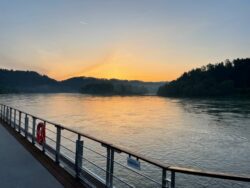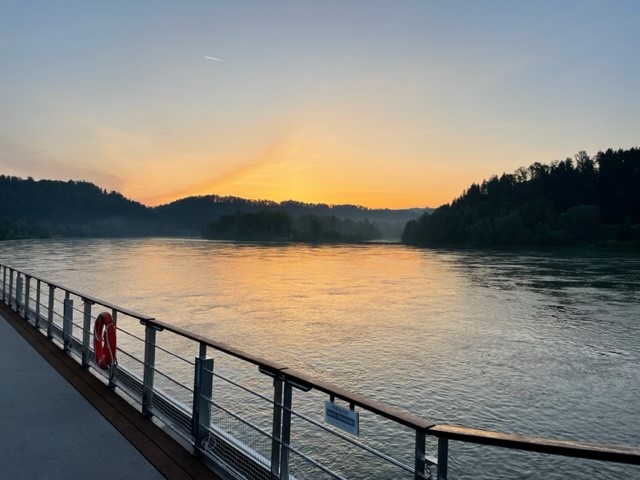The Danube isn’t Blue
Strauss’ waltz notwithstanding, the Danube River is brown.
Its powerful current flows 1,770 miles from the Black Forest in Germany to the Black Sea in Romania, through 10 countries, past four national capitals and through 1,500 years of history.
Gwyn and I took an eight-day cruise upriver from Budapest to Bratislava, Vienna, Krems, the Wachau Valley, Linz and Passau, Germany, just over the Austria border.
It was a moveable and moving feast for us food, travel and history buffs. Of course, I thought about politics.
The first news event I remember was in 1956, when Red Army tanks and soldiers brutally occupied Budapest and gunned down thousands of Hungarian freedom fighters who had risen up and – briefly – kicked the Soviets out.
Hungary’s history is one invasion after another: Celts, Romans, Germanic tribes, Huns (thus the name), Slavs and Ottomans.
Then they were absorbed into the Austro-Hungarian Empire. Then they were on the wrong side of World War I. They lost two-thirds of their land and people in the Versailles Peace Treaty.
Hoping to get its land and people back, Hungary threw in with Hitler in World War II. Hungarian fascists joined in the murder of Jews. Then the Red Army came – and stayed.
Though it wasn’t evident at the time, the 1956 uprising was the first crack that led to the collapse of the Soviet Union in 1989.
Now, unfortunately, Hungary is under the sway of Viktor Orban, an autocrat who – with Putin and Trump – is one of MAGA Republicans’ pinup boys.
Several hundred miles upriver near the end of our cruise was the charming city of Linz, with its squares, churches, cafes, fountains, Maypoles and Mozart House.
Linz is also where Hitler grew up. Just a half-hour north, set on a rolling hillside amid rustic villages and farms, is Mauthausen concentration camp, one of the last of the Nazi death camps to be liberated, by the Third U.S. Army in May 1945.
More than 90,000 people were killed there. It is preserved as a memorial.
It is a grim, somber place.
People over there struggle with their history, just as we do with ours.
Austrians don’t watch The Sound of Music. They don’t want to be reminded of 1938.
Some older Hungarians miss communism. They had jobs for life and pensions. The free market is filled with risks.
Still, thanks to the European Union, people, products, money and, yes, tourists now flow freely where wars and hate once overflowed.
You visit their cities and towns, walk through their cathedrals and cobblestone squares, marvel at their castles and countryside, eat their food (sausages, dumplings, goulash, paprika, big white asparagus, leberkas, langos and Sacher tortes!) and drink their beer and wine.
Their fluency in English shames you, though Gwyn won smiles by knowing a few words and phrases in German and Hungarian, which even Hungarians say is incomprehensible.
You see a bit of how they live – and what their families lived through. You see that all of us want peace and freedom.
But, always, somebody wants to take it away.
For more on what we saw – and ate and drank – check us out on Facebook.


The Danube isn’t Blue


Strauss’ waltz notwithstanding, the Danube River is brown.
Its powerful current flows 1,770 miles from the Black Forest in Germany to the Black Sea in Romania, through 10 countries, past four national capitals and through 1,500 years of history.
Gwyn and I took an eight-day cruise upriver from Budapest to Bratislava, Vienna, Krems, the Wachau Valley, Linz and Passau, Germany, just over the Austria border.
It was a moveable and moving feast for us food, travel and history buffs. Of course, I thought about politics.
The first news event I remember was in 1956, when Red Army tanks and soldiers brutally occupied Budapest and gunned down thousands of Hungarian freedom fighters who had risen up and – briefly – kicked the Soviets out.
Hungary’s history is one invasion after another: Celts, Romans, Germanic tribes, Huns (thus the name), Slavs and Ottomans.
Then they were absorbed into the Austro-Hungarian Empire. Then they were on the wrong side of World War I. They lost two-thirds of their land and people in the Versailles Peace Treaty.
Hoping to get its land and people back, Hungary threw in with Hitler in World War II. Hungarian fascists joined in the murder of Jews. Then the Red Army came – and stayed.
Though it wasn’t evident at the time, the 1956 uprising was the first crack that led to the collapse of the Soviet Union in 1989.
Now, unfortunately, Hungary is under the sway of Viktor Orban, an autocrat who – with Putin and Trump – is one of MAGA Republicans’ pinup boys.
Several hundred miles upriver near the end of our cruise was the charming city of Linz, with its squares, churches, cafes, fountains, Maypoles and Mozart House.
Linz is also where Hitler grew up. Just a half-hour north, set on a rolling hillside amid rustic villages and farms, is Mauthausen concentration camp, one of the last of the Nazi death camps to be liberated, by the Third U.S. Army in May 1945.
More than 90,000 people were killed there. It is preserved as a memorial.
It is a grim, somber place.
People over there struggle with their history, just as we do with ours.
Austrians don’t watch The Sound of Music. They don’t want to be reminded of 1938.
Some older Hungarians miss communism. They had jobs for life and pensions. The free market is filled with risks.
Still, thanks to the European Union, people, products, money and, yes, tourists now flow freely where wars and hate once overflowed.
You visit their cities and towns, walk through their cathedrals and cobblestone squares, marvel at their castles and countryside, eat their food (sausages, dumplings, goulash, paprika, big white asparagus, leberkas, langos and Sacher tortes!) and drink their beer and wine.
Their fluency in English shames you, though Gwyn won smiles by knowing a few words and phrases in German and Hungarian, which even Hungarians say is incomprehensible.
You see a bit of how they live – and what their families lived through. You see that all of us want peace and freedom.
But, always, somebody wants to take it away.
For more on what we saw – and ate and drank – check us out on Facebook.